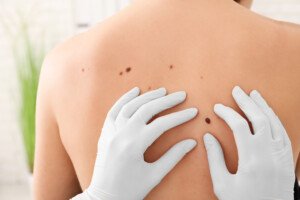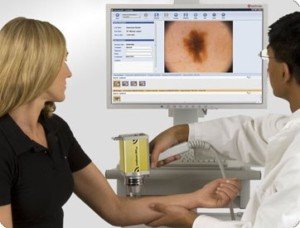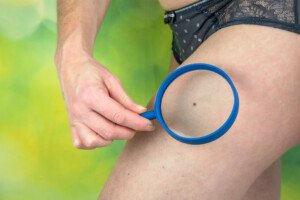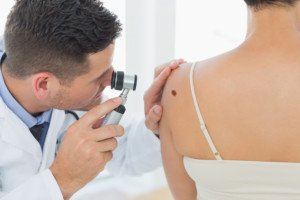
Are you so afraid of your moles that you no longer can look at them, for fear of what you might see?
Serial Digital Dermoscopy
This wonder of technology will give you great peace of mind. I’ve had this procedure electively done and will continue having it done.
Moles are photographed, then examined on the computer screen under high magnification by the dermatologist.

Not only that, but (depending on the specific system) the computer database compares the image to data from melanoma and then comes up with a rating. The rating can be a number or color.
The computer does NOT diagnose melanoma, but it indicates that a mole is suspicious or has characteristics that resemble melanoma more than it resembles a benign lesion.
Based on the rating, the doctor will then decide on further action (or not).
Now imagine the reduction in your anxiety when the doctor tells you, “All of your moles look very stable. You don’t have to come back for another 18 months.”
Serial digital dermoscopy is done yearly, every 18 months or even every two years (depending on the doctor’s recommendations, though you can have it done as often as you’d like).
The same moles are photographed, and the computer program compares new photos to previous images and will detect changes — earlier than a dermatologist possibly can, even with their handheld dermatoscope.
SDD may run about $250, depending on where it’s done.
Home Mole Mapping
Map out your lesions at home (if you don’t have too many), using a large sketch book.
Even if your drawings of various body parts are crude, at least this way you’ll have an idea of where you have moles, so that you will know if new ones have appeared.
This will reduce a lot of anxiety.
Illustrate
If you can illustrate, then draw and render your moles; this will significantly reduce anxiety.
I’ve done this (I can illustrate shape and texture, plus draw scaled-up images; I knew someday this skill would come in handy).
Many artists may not think to do this.
Whip out your favorite illustrating tool and draw your moles, capturing variations in color, patterns, texture, border, etc.
Then, when it’s time to do monthly self-exams, you’ll have a better chance of detecting a change.
Monthly Self-Exam
“An at-home approach to monitoring moles may include the ever popular selfie!” says Emily de Golian, MD, a board certified dermatologist with Forefront Dermatology in Atlanta, GA.

Shutterstock/pixinoo
“Take a photo of any moles in question from a distance for orientation, so you can tell which body part is being photographed, and close-up to capture what the mole looks like in detail,” continues Dr. de Golian.
“You can compare your skin to these selfies periodically, such as during a monthly skin self-exam, and if any changes have occurred, call your dermatologist for an appointment.”
Commit to a self-skin exam every month without fail. This way you won’t wonder, “When did this mole begin changing?” or, “Did this mole look this way only a few weeks ago?” The monthly selfie will cut a lot of anxiety.
Annual Clinical Exam
Have a dermatologist examine your skin from head to toe, and make sure they use a dermatoscope. This will lower anxiety.
“Annual skin exams and any required follow-up are typically covered by insurance,” says Dr. de Golian.
“Patients should call for a sooner follow-up if they notice any new or changing spots.”

shutterstock/wavebreakmedia
Know that only 30 percent of melanomas arise in pre-existing moles (Yale School of Medicine).
Next, to reduce mole anxiety and if you’re tech savvy, you can get an application for your smartphone that works in a similar way to digital serial dermascopy.
There are many apps like this, but they do NOT replace the type of digital serial dermoscopy that was described previously.
Consider it an adjunct to your skin health surveillance program.
Finally, to rid yourself of mole anxiety, have the spot removed and biopsied.
Don’t put this off. Just get it done. Depending on your insurance plan, you won’t have to pay for this other than the copay.
If you want to get rid of mole anxiety as much a possible, the money invested to do this will be well worth it.












